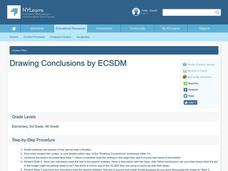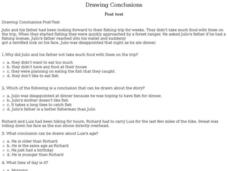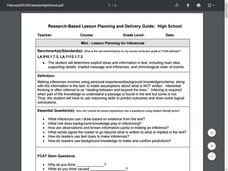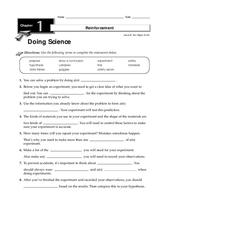Curated OER
Writer's Toolbox
Present the class with a slide show that will give them a great head start in writing expository and narrative texts. The information is highlighted for easy note taking, well organized, and presented in a kid-friendly manner. It...
Curated OER
Results and Conclusions
Fourth graders practice using the scientific method. In this results and conclusions lesson, 4th graders review data collected, create a graph of their data and make their final conclusions about the information collected.
Curated OER
Drawing Conclusions
Students view images and draw conclusions based on what they see happening in the pictures. In this drawing conclusions lesson plan, students also write a paragraph and their classmates have to draw a conclusion based on their writing.
Curated OER
Taking Notes / Making Conclusions Worksheet
In this worlds of work and play worksheet, students make observations about home architecture and gardening as they walk through a neighborhood. Students answer 16 questions that require them to take notes and draw conclusions about...
Curated OER
Drawing Conclusions: Post Test
In this drawing conclusions learning exercise, students read passages and answer multiple choice questions where they draw conclusions from the passage. Students complete 7 questions.
Curated OER
Introduction and Conclusion
In this writing learning exercise, students read about how to write a successful introduction and conclusion. For example, students are encouraged to begin with an incident, real or imagined, which illustrates the point of discussion.
Curated OER
Drawing Conclusions
In this drawing conclusions instructional activity, students read the sentences and select the best word to write complete the story. Students complete 6 examples.
Curated OER
Drawing Conclusions: Hidden Ideas
In this drawing conclusions worksheet, students read a one sentence story. From two choices, students fill in the missing word to tell the story's hidden idea.
Curated OER
Little Boy Blue
First graders read nursery rhymes and celebrate Mother Goose. In this drawing conclusions and predicting lesson, 1st graders create new ending for the nursery rhymes. Students gather data and make a graph showing their favorite rhyme.
Curated OER
Archaeological Inquiry
Students describe what they see as they observe an "artifact". They draw conclusions based on the information gathered to identify what the artifact might be used for and determine how old it might be.
Curated OER
Freshman Project-Part 5
In this project instructional activity, 9th graders display their data, the make a graph and they answer analysis and conclusion questions on their experimental design project. They discuss the variables of their experiment, their major...
Curated OER
Reel Projects
Students investigate projectile motion. In this projectile motion lesson, students investigate a website with an interactive lesson. Students view the changes in the projectile they see in the lesson. Students watch short video clips and...
Curated OER
Write Your Science Research Paper!
In this research paper instructional activity, students fill in an outline of their research project. Included is the title of the project, their hypothesis, an introduction paragraph that they analyze as well four supporting paragraphs...
Curated OER
Drawing Conclusions
For this online, interactive worksheet, 5th graders complete a pre-test in regards to drawing conclusions. Students complete 10 multiple choice questions focusing on obtaining conclusions from the given information and click at the...
Curated OER
Conjectures and Conclusions
Students draw conclusions and make conjectures given a specific scenario. In this geometry lesson, students model real life scenarios using properties of triangles. They model number facts and explain why the outcome is what it is.
Curated OER
Sleeping Beauty Story Board
Have the kids choose a fairy tale and read it independently. Then model writing a conclusion for a narrative piece. They create storyboards based on the chosen plot, then write a new conclusion.
Nancy Fetzer's Literacy Connections
Expository Paragraph
Upper elementary and middle school writers learn how to craft an expository paragraph by following the six steps detailed in a 48-page instructional guide. Learners learn how to write six different types of informational paragraphs: to...
Curated OER
Mini-Lesson Planning for Inferences
Making inferences and drawing conclusions is a key component to successful active reading. Encourage your class to use context clues and prior knowledge to infer different elements of a story, including the setting, plot, and character...
Mr. Science
The Scientific Method
First, ask a question and then, do research. Next, form a hypothesis, and conduct an experiment. Make observations, gather and analyze data, and then state a conclusion based on the results. This is the scientific method, and here is a...
Center for Learning in Action
Investigating Physical and Chemical Changes
Super scientists visit ten stations to predict, observe, and draw conclusions about the physical and chemical changes that occur when different states of matter—liquid, solid, and gas—are placed under a variety of conditions. To...
Bowland
Soft Drinks
"Statistics are no substitute for judgment" - Henry Clay. Young mathematicians use provided statistics from a soda taste test to explain why conclusions are faulty. They devise a new test that would be more appropriate than the one given.
Curated OER
Lesson: Possible Perspectives
Visual art is the inspiration for a creative writing activity focused on having learners write from different perspectives. They analyze the image Yellow Rain Jacket, picking out details to help their storytelling. They use the details...
Curated OER
A Trip to the Fire Station: comprehension skills
In this comprehension skills worksheet, students read the book A Trip to the Fire Station and complete comprehension activities. Students complete activities such as drawing conclusions, making inferences, synthesizing, important...
Curated OER
Doing Science
In this science experiment process worksheet, students will learn about the steps of conducting a science experiment, including creating a hypothesis, collecting data and drawing a conclusion. This worksheet has 8 fill in the blank...

























